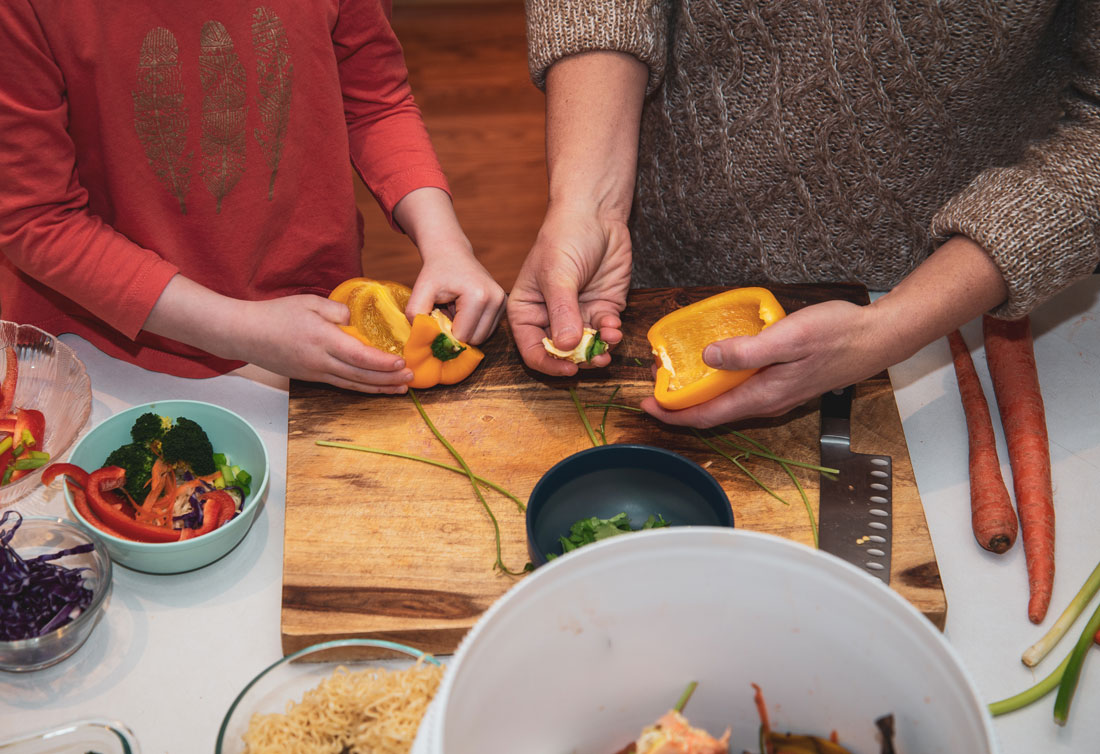
- High Country Conservation
- July 15, 2024
- Ask Eartha
Dear Eartha, I spend every day around food, how do I lower my environmental impact when it comes to the world of food?
An easy way to influence your environmental impact is by starting in your kitchen. The kitchen is a great place to start as we eat food every day and spending more time in the kitchen is an effective way to start making a difference.
Where you Eat
Cooking at home is a great way to lower your environmental impact, compared to dining at restaurants or getting takeout. Take out has many items that you want to try to avoid. While you can refuse to take the single-use service ware, since you have utensils waiting for you at home, your food will still be packaged in a single use container which, for the most part, can’t be recycled. You can eliminate these headaches simply by cooking at home.
While dining in a restaurant eliminates the single-use factor, you still can’t control how sustainable your meal is compared to when you are cooking at home. Cooking at home takes your sustainability game to a whole new level because you can plan your meals effectively and buy only what you need. You can also ensure that food scraps are composted. According to the EPA, food waste makes up 24% of municipal solid waste in the US. Composting is an important tool for reducing greenhouse gas emissions (GHGs) and diverting waste from the landfills. Ready to start composting? Sign up for the FREE local food scrap program on HighCountryConservation.org.
What you Eat
What we choose to put on our plates is just as important as where we eat. Understanding the carbon footprint of your food can help you make informed decisions about what to buy at the grocery store. Basically, a food’s carbon footprint is a combination of GHGs produced by growing, farming, processing, transporting, and storing that food item.
According to the United Nations, when appropriate, shifting to a plant-rich diet is an easy way to reduce food-related GHGs. Increasing your intake of plant proteins (such as beans, chickpeas, and lentils) can reduce the need for high amounts of animal-based foods (meat and dairy) which have a significantly higher carbon footprint due to the larger number of resources needed to grow animals versus plants. For example for each lbs of beef you can account for 155 lbs of GHGs in contrast to a lbs of legumes only having 4.4lbs of GHGs associated with it.
Eating locally is a great way to address the transporting and storage component of your diet’s carbon footprint. Choosing to purchase your produce from local farms eliminates thousands of miles that produce must travel before it makes it to your local grocery store. Food is also transported in a refrigerated truck, adding to the footprint of those food items. Community Supported Agriculture (CSA) is a great way to eat locally. A CSA is a relationship between farmers and community members who pay annual fees to help cover the production costs of the farms. In return members receive ‘shares’ of the farms’ annual production. Interested in buying local, visit your local farmer markets this summer or learn more about the Summit County CSA program at HighCountryConservation.org.
How you cook your food
There are also changes you can make within your kitchen to reduce the environmental impact of your food. One way is by making sure the kitchen products you purchase are made from responsibly sourced materials and ingredients. You can lower the amount of waste you produce by choosing to use cloth napkins instead of paper towels or re-usable cling wraps in place of saran wrap. Larger changes like switching your gas stove to an electric cooktop will help lower your environmental impact as it is more efficient, and the cooktop can be powered by renewable energy sources. HC3 has resources such as a free energy coaching call and rebates for the completion of eligible energy upgrades. You can learn more about these at HighCountryConservation.org.
The kitchen is a beautiful space for many reasons; edible wonders are created there; folks spend quality time together. By making careful decisions about what you bring into your kitchen, you can drastically reduce your carbon footprint, which for me is a beautiful thing! Let’s use the kitchen to not only make our lives healthier but our planet as well!
Ask Eartha Steward is written by the staff at the High Country Conservation Center, a nonprofit dedicated to waste reduction and resource conservation. Submit questions to Eartha at info@highcountryconservation.org.
